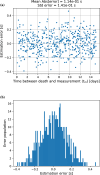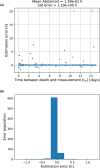A novel method for assessing postmortem interval using radon radioisotopic decay - an internal radon 'time of death clock'
- PMID: 40783585
- PMCID: PMC12335445
- DOI: 10.1038/s41598-025-15168-5
A novel method for assessing postmortem interval using radon radioisotopic decay - an internal radon 'time of death clock'
Abstract
Estimating the postmortem interval (PMI)-the time since death-remains a longstanding challenge in forensic and biological sciences due to the complex influence of environmental and physiological variables. Here, we present a novel computational framework that leverages the physical principles of radioactive decay to estimate PMI using the relative isotope abundances of radon progeny ([Formula: see text], [Formula: see text], and [Formula: see text]) in biological tissue. Our approach models the decay chain of inhaled [Formula: see text] and solves the associated system of differential equations to determine PMI based on isotope ratio dynamics. A key innovation is the use of paired measurements taken at two postmortem time points to capture the time-derivative of the decay curve, enhancing solution uniqueness, reducing dependence on prior exposure history, therefore minimizing error. Monte Carlo simulations were employed to assess model performance. If validated empirically, this approach lays the groundwork for a physics-based method for PMI estimation with potential applications in forensic science and radiation biology.
© 2025. The Author(s).
Conflict of interest statement
Declarations. Competing interests: The authors declare no competing interests.
Figures




Similar articles
-
Human Decomposition and Time Since Death: Persistent Challenges and Future Directions of Postmortem Interval Estimation in Forensic Anthropology.Am J Biol Anthropol. 2024 Dec;186 Suppl 78(Suppl 78):e70011. doi: 10.1002/ajpa.70011. Am J Biol Anthropol. 2024. PMID: 40071863 Free PMC article.
-
Interventions to reduce harm from continued tobacco use.Cochrane Database Syst Rev. 2016 Oct 13;10(10):CD005231. doi: 10.1002/14651858.CD005231.pub3. Cochrane Database Syst Rev. 2016. PMID: 27734465 Free PMC article.
-
Circular RNA circFat3 as a biomarker for construction of postmortem interval Estimation models in mouse brain tissues at multiple temperatures.Sci Rep. 2025 Jul 1;15(1):21577. doi: 10.1038/s41598-025-07998-0. Sci Rep. 2025. PMID: 40593252 Free PMC article.
-
Potential Role of mRNA in Estimating Postmortem Interval: A Systematic Review.Int J Mol Sci. 2024 Jul 26;25(15):8185. doi: 10.3390/ijms25158185. Int J Mol Sci. 2024. PMID: 39125753 Free PMC article.
-
Usefulness of ultrastructure studies for the estimation of the postmortem interval. A systematic review.Rom J Morphol Embryol. 2017;58(2):377-384. Rom J Morphol Embryol. 2017. PMID: 28730221
References
-
- Ruiz López, J. L. & Partido Navadijo, M. Estimation of the post-mortem interval: a review. Forensic science international369, 112412 (2025). - PubMed
-
- Madea, B. Handbook of Forensic Medicine (John Wiley & Sons, Incorporated, Newark, 2014), 1 edn.
-
- Sutton, L. & Byrd, J. An introduction to postmortem interval estimation in medicolegal death investigations. WIREs Forensic Sci. 2, e1373, 10.1002/wfs2.1373 (2020).
MeSH terms
Substances
Grants and funding
- RGPIN-2020-04212/Natural Sciences and Engineering Research Council of Canada
- RGPIN-2023-05167/Natural Sciences and Engineering Research Council of Canada
- RGPIN-2023-05167/Natural Sciences and Engineering Research Council of Canada
- 39871/Canada Foundation for Innovation
- 39871/Canada Foundation for Innovation
- No number available/Alberta Cancer Foundation
- No number available/Alberta Cancer Foundation
- No number available/Arnie Charbonneau Cancer Institute, University of Calgary
- No number available/Arnie Charbonneau Cancer Institute, University of Calgary
- No number available/Ministry of Economic Development and Trade, Government of Alberta
- No number available/Ministry of Economic Development and Trade, Government of Alberta
LinkOut - more resources
Full Text Sources
Medical

